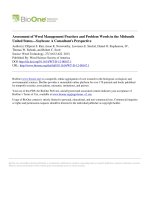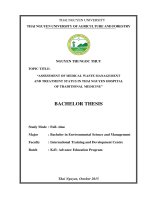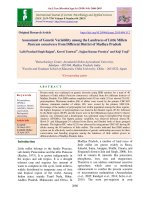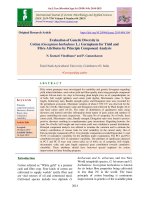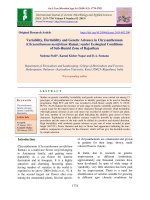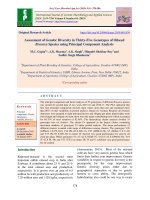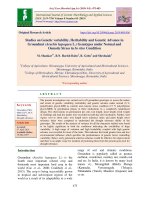Assessment of genetic variability, heritability and genetic advance in chrysanthemum (Dendranthema grandiflora Tzvelve)
Bạn đang xem bản rút gọn của tài liệu. Xem và tải ngay bản đầy đủ của tài liệu tại đây (295.87 KB, 10 trang )
Int.J.Curr.Microbiol.App.Sci (2018) 7(8): 4544-4553
International Journal of Current Microbiology and Applied Sciences
ISSN: 2319-7706 Volume 7 Number 08 (2018)
Journal homepage:
Original Research Article
/>
Assessment of Genetic Variability, Heritability and Genetic Advance in
Chrysanthemum (Dendranthema grandiflora Tzvelve)
Mallikarjun Hebbal1*, Mukund Shiragur1, Mahantesha B.N. Naika2,
G.K. Seetharamu1, Sandhyarani Nishani2 and B.C. Patil1
1
Department of Floriculture and Landscape Architecture, University of Horticultural
Sciences, Bagalkot, Karnataka, India
2
Department of Crop Improvement and Biotechnology, KRCCH, Arabhavi-591218, University
of Horticultural Sciences, Bagalkot, Karnataka, India
*Corresponding author
ABSTRACT
Keywords
Chrysanthemum, genetic
variability (GCV, PCV),
heritability, genetic
advance (GAM)
Article Info
Accepted:
26 July 2018
Available Online:
10 August 2018
Ten genotypes of chrysanthemum were evaluated under naturally-ventilated polyhouse in
Completely Randomized Block Design during the year 2017-18 to determine genetic
variability, heritability and genetic advance for different quantitative and qualitative traits,
based on which selection may be made. Analysis of Variance showed significant
differences among genotypes for all the characters studied. Results revealed that
magnitude of the Phenotypic Coefficient of Variation (PCV) was higher than Genotypic
Coefficient of Variation (GCV) for all the traits, indicating genotype and environment
interaction. High (>20%) PCV and GCV was observed for number of secondary branches,
number of leaves, leaf area, stem girth, days to flower bud initiation and days to first
flowering. Heritability estimates ranged from a moderate 55.10% (number of secondary
branches/plant) to high as 99.74% (Days to flower bud initiation). High heritability
(>60%) was observed for all traits except number of secondary branches/plant. Estimates
of high heritability coupled with high genetic advance as per cent of mean (GAM) were
observed for all the growth, flowering, yield and quality parameters studied indicating the
possible role of additive gene action.
Introduction
Flowers and flowering plants are fascinating
part of our life. Among them, chrysanthemum
(chryos - golden; anthos - flower) called as
“Queen of the East” is a most interesting and
popular flower crop of commercial
importance. It ranks third in the International
cut flower trade next to rose and carnation in
demand and popularity. Chrysanthemum is
native to China, belonging to the family
Asteraceae which is the most phylogenetically
advanced dicotyledonous
family. The
inflorescence is called as capitulum or head
consisting of large number of tiny florets
closely mounted on a flattened stem end,
which gives a false appearance of single
bloom. Garden chrysanthemum which was
previously known as Chrysanthemum
morifolium (Ramat) and now it is called as
4544
Int.J.Curr.Microbiol.App.Sci (2018) 7(8): 4544-4553
Dendranthema grandiflora (Tzvelev) Kumbar
et al., (2017). In India chrysanthemum
commercially cultivated in states like Tamil
Nadu, Karnataka, Maharashtra, Rajasthan,
Madhya Pradesh and Bihar. Its cultivation is
popular around the cities like Delhi, Kolkata,
Lucknow, Kanpur, Chennai, Allahabad and
Bengaluru. It is grown in an area of 5,453 ha
with production of 59,543 Mt and productivity
of 10.92 t/ha in Karnataka state for loose
flower purpose (Anon., 2016). Still, there is a
need to increase chrysanthemum cultivation
which is limiting due to lack of high yielding
varieties with attractive flowers.
The phenotypic expression of the plant
character is mainly controlled by the genetic
makeup of the plant and the environment in
which it is grown plus the interaction between
the genotypes and environment. Further, the
genotype of the plant is controlled by different
gene action i.e. additive gene effect
(heritable), non-additive gene effect or
dominance (non-heritable) and epistasis (nonallelic dominance).
Therefore, it becomes necessary to partition
the observed phenotypic variability into its
heritable parameters such as coefficient of
variation, heritability and genetic advance
Panse and Sukhatme (1967). Hence, a study
was conducted to evaluate the genetic
variability, heritability and genetic advance of
different chrysanthemum genotypes.
Materials and Methods
The experiment was conducted to study the
genetic variability, heritability and genetic
advance
of
different
genotypes
of
chrysanthemum (Dendranthema grandiflora
Tzvelve).
The
experimental
material
comprised of ten chrysanthemum genotypes
such as Marigold, Dall White, Karnool, Dall
Yellow, Poornima Yellow, Poornima Pink,
Calcutta Shantini, Poornima Red, Poornima
White and Dundi. The genotypes were
evaluated in Complete Randomized Design
with three replications during kharif 2017-18
at K. R. C. College of Horticulture, Arabhavi.
The plants were planted at a spacing of 60 X
45 cm and all the recommended cultural
practices were followed. Five competitive
plants were tagged at random in each
treatment in each replication for recording
detailed observation and the data were
recorded for all the 19 quantitative and
qualitative characters viz., plant height,
number of primary and secondary branches,
number of leaves at 90 days after planting,
leaf area (cm2), stem girth, days taken for
flower bud initiation, days to first flowering,
days for 50 per cent flowering, duration of
flowering (days), number of flowers per plant,
individual flower weight (g), hundred flowers
weight (g), diameter of flower (cm), shelf life
(h) and flower yield per plant (g/plant) were
recorded. Mean values were subjected to
analysis of variance, genotypic and phenotypic
coefficient of variation were estimated based
on estimate of genotypic and phenotypic
variance (Burton and Devane.,1953, broad
sense heritability was calculated as ratio of
genotypic variance to phenotypic variance and
expressed in percentage, genetic advance was
calculated using formula given by Robinson et
al., (1949), genetic advance as per cent over
mean was worked out and categorized as
suggested by Johnson et al., (1955).
The present investigation was carried out
using ten genotypes of chrysanthemum to
assess the extent of genetic variability and
diversity based on morphological basis.
Further, the genetic components like
genotypic coefficient of variation (GCV),
phenotypic coefficient of variation (PCV),
heritability (broad sense), genetic advance
(GA) and genetic advance as per cent mean
(GAM) studies were also conducted for
growth, flowering, yield and quality
parameters.
4545
Int.J.Curr.Microbiol.App.Sci (2018) 7(8): 4544-4553
The range in the values reflect the amount of
phenotypic variability, which is not very
reliable since it includes genotypic,
environmental and genotype x environmental
interaction components and does not reveal as
to which character showing higher degree of
variability. Further, the phenotype of the crop
is influenced by additive gene effect
(heritable), dominance (non- heritable) and
epitasis (non- allelic interaction). Hence, it
becomes necessary to work out the observed
variability into phenotypic coefficients of
variability (PCV) and genotypic coefficients
of variability (GCV), which ultimately
indicate the extent of variability existing for
various traits. However, even this does not
give a true picture about the extent of
inheritance of the character.
Heritability (h2) and genetic advance over per
cent mean (GAM) varied for growth
parameters. Higher heritability indicates the
effectiveness of selection through phenotypic
performance, but it does mean a high genetic
gain. The magnitude of heritable variability is
the most important aspect of the genetic
constitution of breeding material. However,
high heritability associated with high GAM
proves more useful for efficient improvement
of a character through simple selection (Panse
and Sukhatme, 1967).
The effectiveness of selection for any
character does not depend on the amount of
variability alone but also with estimates of
heritability. It is of great interest to the plant
breeder to determine how much of the
phenotypic variability which is present in a
particular generation is heritable and the
accuracy with which a genotype can be
evaluated by its phenotypic expression.
Therefore, the heritability (h2) of a character
can be relied upon, as it enables them to
decide the extent of selection pressure to be
applied under particular environment, which
separate out the environmental influence from
the total variability. Nevertheless, its use
would be limited as this is prone to changes in
environment, material, etc. The estimation of
heritability has a greater role to play in
determining the effectiveness of selection of a
character provided it is considered in
conjunction with the predicted genetic
advance as suggested by Johnson et al., (1955)
and Panse and Sukhatme (1967). Since,
heritability is influenced by bio-metrical
method, generation of hybrid, sample size of
experimental material and environment
(Hanson, 1963).
Analysis of variance
Results and Discussion
Assessment of genetic variability and
genetic diversity based on morphological
traits
The analysis of variance for different
quantitative characters revealed significant
(P=0.05) differences among the genotypes for
all the growth parameters, flowering, yield and
quality parameters.
Genetic variability
To understand the extent of the observed
variations due to genetic factors, viz., the
genotypic coefficient of variation (GCV),
phenotypic coefficient of variation (PCV),
broad sense heritability (h2), genetic advance
(GA) and genetic advance as per cent of mean
(GAM) were studied (Fig. 1). The Data
revealed the existence of large amount of
variability with respect to all characters
studied as given in Table 1.
Growth parameters
The estimates of moderate genotypic and
phenotypic coefficient of variations for plant
height at 90 days after planting were 15.57 per
cent and 17.67 per cent, respectively. The high
heritability (77.70%) was observed for plant
4546
Int.J.Curr.Microbiol.App.Sci (2018) 7(8): 4544-4553
height with moderate genetic advance as per
cent of mean (28.27%). The estimates of
genotypic coefficient of variations for number
of primary branches at 90 days was moderate
19.60 per cent and phenotypic coefficient of
variation was high 24.44 per cent respectively.
The high heritability and high genetic advance
as per cent of mean were 64.30 per cent and
32.36 per cent respectively for this trait.
The estimates of genotypic and phenotypic
coefficient of variations for number of
secondary branches at 90 days were high as
33.97 and 45.76 per cent respectively. The
moderate heritability and high genetic advance
as per cent of mean (55.10%) and (51.96%),
respectively were observed.
Numbers of leaves per plant at 90 days
showed high estimates of genotypic and
phenotypic coefficients of variations (70.95
per cent and 71.92 per cent respectively).
Whereas, high heritability of 97.30 per cent
was observed with high genetic advance as per
cent of mean (94.78%).
Plant spread in East-West direction at 90 days
after planting showed high estimates of
genotypic and phenotypic coefficient of
variations 21.21 per cent and 22.80 per cent,
respectively. The high heritability (86.60%)
was observed for plant spread with high
genetic advance as per cent of mean (40.66%).
Plant spread in North- South direction at 90
days after planting showed moderate
genotypic and high phenotypic coefficient of
variations 16.95 per cent and 20.17 per cent,
respectively. The high heritability (70.70%)
was observed for plant spread with high
genetic advance as per cent of mean (29.35%).
The genotypic and phenotypic coefficients of
variations of leaf area were high as 32.66 per
cent and 33.95 per cent respectively. High
heritability 92.60 per cent coupled with high
genetic advance as per cent of mean (64.73%)
was observed for this trait.
The genotypic and phenotypic coefficients of
variations for stem girth of the plant were high
22.60 per cent and 23.29 per cent,
respectively. High heritability (94.20%)
coupled with high genetic advance as per cent
of mean (45.19%) was noticed for this trait.
The coefficients of variations for both the
genotypic and phenotypic for growth
parameters revealed that the low differences
were observed for number of primary,
secondary branches and number of leaves,
plant spread in E-W and N-S (at 90 DAP),
stem girth and leaf area thus suggesting the
major contribution of genetic variability
towards the total variance indicating ample
scope for improvement. Similar trend was
reported in chrysanthemum for all the
characters was noticed and as reported by
Chaugule (1985); Shiragur (2009) and Kore
(2014) in China aster.
In present study, estimates of high heritability
with high genetic advance over per cent mean
(GAM) were observed for plant height,
number of primary and secondary branches
per plant, number of leaves per plant, leaf area
and stem girth indicating the possible role of
additive gene action. The results are in
conformity with observation made by Negi et
al., (1983) and Kore (2014) for plant height in
China aster, number of leaves per plant
(Kannan and Ramdas, 1990) in gerbera and in
chrysanthemum by Talukdar et al., (2003) and
Shiragur (2009).
Flowering parameters
High estimates of GCV (21.05%) and PCV
(21.09%) coupled with high heritability
(99.74%) and high genetic advance as per cent
of mean (43.18%) observed for days to flower
bud initiation.
4547
Int.J.Curr.Microbiol.App.Sci (2018) 7(8): 4544-4553
Table.1 Genetic estimates for various growth, flowering, yield and quality parameters in chrysanthemum
Sl. No.
Character
GCV (%)
PCV (%)
h² (%)
GAM (%)
15.57
19.6
33.97
70.95
21.21
16.95
32.66
17.67
24.44
45.76
71.92
22.8
20.17
33.95
77.7
64.3
55.1
97.3
86.6
70.7
92.6
28.27
32.36
51.96
94.78
40.66
29.35
64.73
22.6
23.29
94.2
45.19
21.05
21.03
18.94
14.38
21.09
21.16
19.02
14.97
99.74
99.43
99.6
96.02
43.18
43.34
38.78
27.89
29.75
24.76
24.77
30.38
26.12
26.13
95.9
89.9
89.9
60.02
48.36
48.06
25.74
25.76
14.76
21.36
26.36
26.38
15.12
22.01
95.4
95.3
95.3
94.2
51.8
53.5
28.69
42.72
(a) Growth parameters
1
2
3
4
5
6
7
Plant height (cm) at 90 DAP
Number of primary branches (90 DAP)
Number of secondary branches (90 DAP)
Number of leaves per plant (90 DAP)
Plant spread in E-W (cm) (90 DAP)
Plant spread in N-S (cm) (90 DAP)
Leaf area (cm2)
Stem girth (mm)
8
(b) Flowering parameters
Days to first bud initiation
1
Days to first flowering
2
Days to 50% flowering
3
Duration of flowering (days)
4
(c) Yield parameters
Number of flowers/plant
1
Flower yield/plant (g)
2
Flower yield per ha (t)
3
(c) Quality parameters
Individual flower weight (g)
1
Weight of 100 flowers (g)
2
Flower diameter (cm)
3
Shelf life (hours)
4
4548
Int.J.Curr.Microbiol.App.Sci (2018) 7(8): 4544-4553
Fig.1 The graph showing genetic variability in chrysanthemum genotypes
4549
Int.J.Curr.Microbiol.App.Sci (2018) 7(8): 4544-4553
High estimates of GCV (21.03%) and PCV
(21.16%) coupled with high heritability
(99.43%) and high genetic advance as per
cent of mean (43.34%) observed for days
taken to first flowering. Moderate estimates of
GCV (18.94%) and PCV (19.02%) coupled
with high heritability (99.60%) and high
genetic advance as per cent of mean
(38.78%).
Moderate estimates of GCV (14.40%) and
PCV (14.80%) coupled with high heritability
(96.02%) and high genetic advance as per
cent of mean (27.89%) were recorded for
flowering duration in chrysanthemum.
Significant variations were observed for
flowering parameters, indicating the wide
variability present among the genotypes. The
phenotypic coefficient of variability (PCV)
was higher than the genotypic coefficients of
variability (GCV) for the flowering characters
studied. Similar results were obtained by
Chaugale (1985) and Shiragur (2009) in
chrysanthemum and Naik et al., (2004) in
China aster.
It is obvious because PCV embodies
variability due to genotypes, environment and
genotype x environment interaction. The
differences among the phenotypic coefficients
of variations and genotypic coefficients of
variations were very less for leaf area, days to
flower bud initiation, days taken for first
flowering, days to 50 per cent flowering and
duration of flowering indicating that, the
flowering nature of chrysanthemum is more
of genetically controlled, as it is short day
plant i.e less role of environment or
contribution of genetic variability towards
total variance similar trend shown by Sathian
(2015) in chrysanthemum and Kore (2014) in
China aster. It may be concluded that these
are the characters in chrysanthemum breeding
programme for effective utilization of the
existing variability.
Similarly high heritability coupled with high
genetic advance over per cent mean was
exhibited for days taken for first flowering,
days taken for 50 per cent flowering and
duration of flowering, which indicating the
predominance of additive components.
Thus direct selection helps in improving the
characters. Similar results were obtained by
Raghav and Negi (1994) in China aster for
duration of flowering in African marigold by
Kishore and Raghava (2001) for days taken
for 50 per cent flowering.
Yield parameters
The genotypic coefficients of variations
(29.75%) and phenotypic coefficients of
variations (30.38%) were high for number of
flowers. Heritability was high (95.90%) with
high genetic advance as per cent of mean
(60.02%).
Flower yield per plant (g) showed high
estimates of GCV (24.76%) and PCV
(26.12%) coupled with high heritability
(89.90%) and high genetic advance as per
cent of mean (48.36%).
The variability estimates for flower yield per
hectare (t) showed high GCV (24.77%) and
PCV (26.13%) coupled with high heritability
(89.90%) and genetic advance as per cent of
mean of (48.06%).
The yield parameters also exhibited high
genetic variability for most of the characters
indicating the adequate amount of genetic
variability existed in the material. Sufficient
genetic variability which can be exploited by
selection. However, the difference among
phenotypic coefficient of variation and
genotypic coefficient of variation was very
less indicating the contribution of genetic
variability to the total variability. Similar
results were obtained by Janakiram and Rao
4550
Int.J.Curr.Microbiol.App.Sci (2018) 7(8): 4544-4553
(1991) for total flower yield per plant in
African marigold and Shiragur (2009) in
chrysanthemum.
In the present investigation, high heritability
estimates associated with high genetic
advance was noticed for number of flowers
per plant, flower yield per plant and flower
yield per hectare indicating the role of
additive gene action. Similar results reported
by Chaugule (1985), Chezhiyan et al., (1985);
Barigidad (1992); Sirohi and Behera (2000)
and Talukdar et al., (2003) and Sathian (2015)
in chrysanthemum; Mathew et al., (2005);
Singh and Saha (2006); Singh et al., (2008)
and Kavitha and Anburani (2010) in
marigold. Overall yield and yield contributing
characters have exhibited high genetic
variability coupled with moderate GA,
indicating the scope for further improvement.
Quality parameters
High estimates of GCV (25.74%) and PCV
(26.36%) were coupled with high heritability
(95.40%) and high genetic advance as per
cent of mean (51.80%) were observed for
individual flower weight.
High estimates of GCV (25.76%) and PCV
(26.38%) were coupled with high heritability
(95.30%) and high genetic advance of 53.50
per cent of mean were observed for hundred
flowers weight. The genotypic coefficient of
variation (14.76%) and phenotypic coefficient
of variation (15.12%) were moderate for
flower diameter. High heritability of 95.3 per
cent of mean was coupled with moderate
genetic advance of 28.69 per cent of mean
recorded for this trait.
Shelf life showed high estimates of GCV
(21.36%) and PCV (22.01%) coupled with
high heritability (94.20%) and moderate
genetic advance as per cent of mean
(42.72%).
For quality parameters, the ANOVA indicates
high significant difference. Phenotypic
coefficient of variation was higher than
genotypic coefficient of variation. High
estimates of heritability associated with high
genetic advance were observed for hundred
flower weight, single flower weight and
flower diameter. Similar results were obtained
in chrysanthemum for flower diameter by
Barigidad (1992) and Sirohi and Behera
(2000).
Improving flowering parameters are ultimate
goal in the breeding programme; they need a
wide range of variability for the important
characters. In present investigation, wide
variability was observed for important
characters like stem girth, diameter of flower
and number of flowers per plant. Hence,
careful selection may be practiced for
improving
the
characters
through
hybridization followed by selection.
Analysis of Variance showed significant
differences among genotypes for all the
characters studied. Results revealed that
magnitude of the Phenotypic Coefficient of
Variation (PCV) was higher than Genotypic
Coefficient of Variation (GCV) for all the
traits, indicating genotype and environment
interaction. High (>20%) PCV and GCV was
observed for number of secondary branches,
number of leaves, leaf area, stem girth, days
to flower bud initiation and days to first
flowering. Heritability estimates ranged from
a moderate 55.10% (number of secondary
branches/plant) to high as 99.74% (Days to
flower bud initiation). High heritability
(>60%) was observed for all traits except
number
of
secondary
branches/plant.
Estimates of high heritability coupled with
high genetic advance as per cent of mean
(GAM) were observed for all the growth,
flowering, yield and quality parameters
studied indicating the possible role of additive
gene action.
4551
Int.J.Curr.Microbiol.App.Sci (2018) 7(8): 4544-4553
References
Anonymous, 2016, Area and production
database, Dept. of Horticulture, Govt. of
Karnataka.
Barigidad, H., Patil, A. A. and Nalawadi, U.
G., 1992, Variability studies in
chrysanthemum. Prog. Hort., 24 (1-2):
55-59.
Burton, G. W. and Dewane, E. M., 1953,
Estimating heritability from replicated
clonal material. Agron. J., 45: 478-481.
Chaugule, B. B., 1985, Studies on genetic
variability
in
chrysanthemum
(Chrysanthemum morifolium). M. Sc.
(Agri) Thesis, Mahatma Phule Agril.
Univ., Rahuri.
Chezhiyan, N., Ponnuswami, V., Thamburaj,
S., Khader, J. M. A., Nangan, K. and
Gunashekaran, N., 1985, Evaluation of
chrysanthemum cultivars. South Ind.
Hort., 33: 279-282.
Hanson, W. D., 1963, Heritability. Symp.
Statist. Genet. Pt. br., Raleigh, Cardina,
pp: 425-430.
Janakiram, T. and Rao, T. M., 1991, Genetic
improvement
of
marigold.
In
Floriculture Technology, Trade and
Trends. Ed. Prakash, J and Bhandary,
K. R., Oxford and IBH Company
Private Limited, New Delhi, pp. 331335.
Johnson, H. W., Robinson, H. F. and
Comstock, R. E., 1955, Estimates of
genetic and environmental variability in
soyabeans. Agron. J., 47: 314-318.
Kannan, M. and Ramdas, S., 1990, Variability
and heritability studies in gerbera. Prog.
Hort., 22: 72-76.
Kavitha, R and Anburani, A., 2010, Genetic
variability in African marigold (Tagetes
erecta L.). Asian. J. Hort. 5 (2): 344346.
Kishore, N. and Raghava, S. P. S., 2001,
Variability studies in African marigold
(Tagetes erecta L.). J. Orn. Hort, New
Series, 4 (2): 124-125.
Kore, R., 2014, Studies on genetic variability
and molecular characterization in China
aster (Callistephus chinensis [L.]
Nees.). M. Sc. (Hort.) Thesis. UHS
Bagalkot.
Kumbar, I., Patil, C. P., Kulkarni, B. S.,
Shiragur, M. and Shirol, A. M., 2017,
Efficacy of Entrophospora sp. (VA
Mycorrhiza) on salt tolerance and
flower
yield
and
quality
of
chrysanthemum
var.
Marigold
(Dendranthema grandiflora Tzvelev).
Int.J.Curr.Microbiol.App.Sci.
6(10):
4769-4777.
Mathew, R., Hatia, S. K., Beniwal, B. S. and
Deswal, D. P., 2005, Correlation and
path analysis in flower production and
seed yield in marigold. National
symposium on recent trend and future
strategies. Orn. Hort. pp: 105-108.
Naik, B. H., Basavaraj, N. and Patil, V. S.,
2004, Correlation studies in China aster
(Callisthephus
chinensis
Ness.)
genotypes. J. Orn. Hort., 7(3-4) 81-86.
Negi, S. S., Ragava, S. P. S., Sharma, T. V. R.
S. and Sreenivasan, R. R., 1983, Studies
on variability and correlation in China
aster. Indian J. Hort, 40: 102-106.
Panse, V. G. and Sukhatme, P. V., 1967,
Statistical methods for agricultural
workers, ICAR. New Delhi.
Raghava, S. P. S. and Negi, S. S., 1994,
Genetic analysis of various quantitative
traits in China aster (Callisthephus
chinensis Ness.). Indian J. Hort. 51(1):
106-110.
Robinson, H. F., Comstock, R. E. and Harvey,
P. M., 1949, Estimates of heritability
and degree of dominance in corn.
Agron. J., 41: 353-359.
Sathian, L., 2015, Morphological and
molecular
characterization
of
chrysanthemum
(Dendranthema
4552
Int.J.Curr.Microbiol.App.Sci (2018) 7(8): 4544-4553
grandiflora Tzelev) genotypes. M. Sc
(Hort.) Thesis. UHS Bagalkot.
Shiragur, M., 2009, Characterization of
chrysanthemum
(Dendranthema
grandiflora
Tzvelev.)
germplasm
through morphological and molecular
markers, Ph. D Thesis Univ. Agril. Sci.,
Bangalore.
Singh, K. P. and Saha, T. N., 2006, Genetic
variability, heritability and genetic
advance in French marigold (Tagetes
patula L.). Ind J. Pla. Gen. Res., 19(2):
42-43.
Singh, K. P., Raju, D. V. S., Prasad, K. V. and
Bharadwaj, C., 2008, Studies on genetic
variability, heritability and genetic
advance in French marigold (Tagetes
patula L.). J. Orn. Hort., 12 (1): 30-34.
Sirohi, P. T. and Behera T. K., 2000, Genetic
variability in chrysanthemum. J. Orn.
Hort., (New series), 3(1): 34-36.
Talukdar, M. C., Mahanta, S., Sharma, B. and
Das, S., 2003, Extent of genetic
variation for growth and floral
characters in chrysanthemum cultivars
under Assam condition. J. Orn. Hort.,
6(3): 201-211.
How to cite this article:
Mallikarjun Hebbal, Mukund Shiragur, Mahantesha B.N. Naika, G.K. Seetharamu,
Sandhyarani Nishani and Patil, B.C. 2018. Assessment of Genetic Variability, Heritability and
Genetic
Advance
in
Chrysanthemum
(Dendranthema
grandiflora
Tzvelve).
Int.J.Curr.Microbiol.App.Sci. 7(08): 4544-4553. doi: />
4553
